How To Use Mite Away Quick Strips
An Early Summer Examination of Mite-Away-Quick Strips(tm)
An Early Summer Test of Mite-Away Quick StripsTM
First published in ABJ September 2011
Randy Oliver
ScientificBeekeeping.com
In the Feb event of this Journal, I wrote near a fall trial that I performed with the new formic acrid commitment method—Mite-Away Quick Strips (MAQSTM). I had been impressed by their efficacy and ease of use. Imagine my surprise and dismay when I received a couple of phone calls from beekeepers in California'southward Central Valley this spring lamenting that they had tried the strips, and that information technology looked like their hives had suffered from excessive queen losses!
In short gild I was in advice with David VanderDussen, the developer of the strips, and worked with him and the beekeepers to resolve the issue (David went so far every bit to brand a special trip to California to check things out personally).
The issue appeared to revolve around a few questions:
- Amount of ventilation—the hives involved had 3/8" beeways, rather than the iii/4" beeways on the hives that I had tested.
- The queens may have been old, and there was a good deal of natural queen loss and/or supersedure this spring.
- There appeared to be major breed loss.
- Awarding was just prior to the dear flow, and the beekeepers were worried about loss of ingather.
- The stumper was that some colonies appeared to be unaffected, whereas others in the aforementioned yard appeared to be hit difficult.
A New Trial
I set upwardly a new trial in order to try to indistinguishable the situations reported to me. Since I alive at higher superlative, I had the luxury of some time, since similar conditions would non arrive at my location for a few weeks. I ready a yard with hives containing iind-year queens, of the same strength as those with the reported problems, and built new bottom boards with the same 3/8" beeways.
Rainy weather delayed my trial a bit, and so it broke and warmed but as the master menstruum came on. It'due south probably best to simply nowadays my experimental log:
6/8/eleven–Solar day 0
xx hives, doubles, 10 frames of drawn comb per box, 9-12 frame forcefulness, all twond-year queens, low-cal nectar flow on, temps in mid 70'sF.
Most bees in bottom boxes, and working upward into 2nd box of drawn comb. Well-nigh (except # 6 & 7) had breed in upper box.
Poor weather in previous weeks, merely lots of broodrearing due to syrup feeding & plentiful pollen—mostly young brood. All queens laying well.
Swapped to solid 3/8″ bottoms and checked all for queenrightness, and mite levels past alcohol wash.
half dozen/nine–Day 1
Ranked colonies by mite level. The 2 highest got half treatment (one strip merely). The remainder were assigned treatments alternating by mite levels.
6 treated with 2 strips (N = normal)
6 ditto, but upper box set back 3/4″ for increased ventilation per mfr recommendation (S = setback)
half dozen command sham treatments (folded newspaper), no setback (C = command)
2 with highest mite counts treated with ane strip only, no setback (H = half handling).
Weighed all hives to decide starting weights, in order to encounter whether treatment would affect the love ingather over the next few weeks.
Practical MAQS per mfr directions. Anonymous began almost immediately in all treated hives.
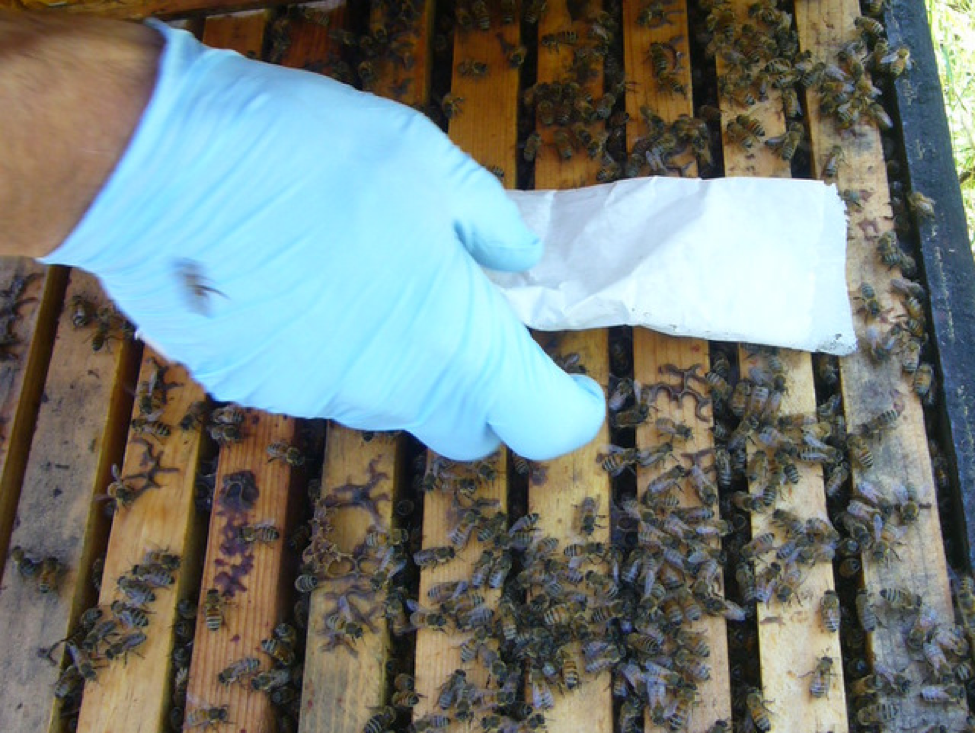
Application of a MAQS. Test hives had from 9 to 12 frames covered with bees.

Typical set back of upper box for added ventilation.
6/10–Solar day 2 (24 hrs post treatment)
Bearding on most treated hives, more on non vented, but anonymous at vents. Anonymous even with single MAQS. Paper sham treatments mostly chewed away and removed. Per mfr'southward circumspection, I did not inspect any brood frames.
Bees adequately close to strips and ignoring them. Noticable formic smell nearly entrances.
Brood carcasses on peak of strips and on bottom boards, simply varies from hive to hive. Appears to be less brood kill on vented, but not sure. No noticeable brood impale with single strip, but notable mite drop.

Typical bearding shortly later application. This behavior continued through the next twenty-four hour period.

Anonymous at setback was typical, but colonies appeared to tolerate the fumes better with setbacks.
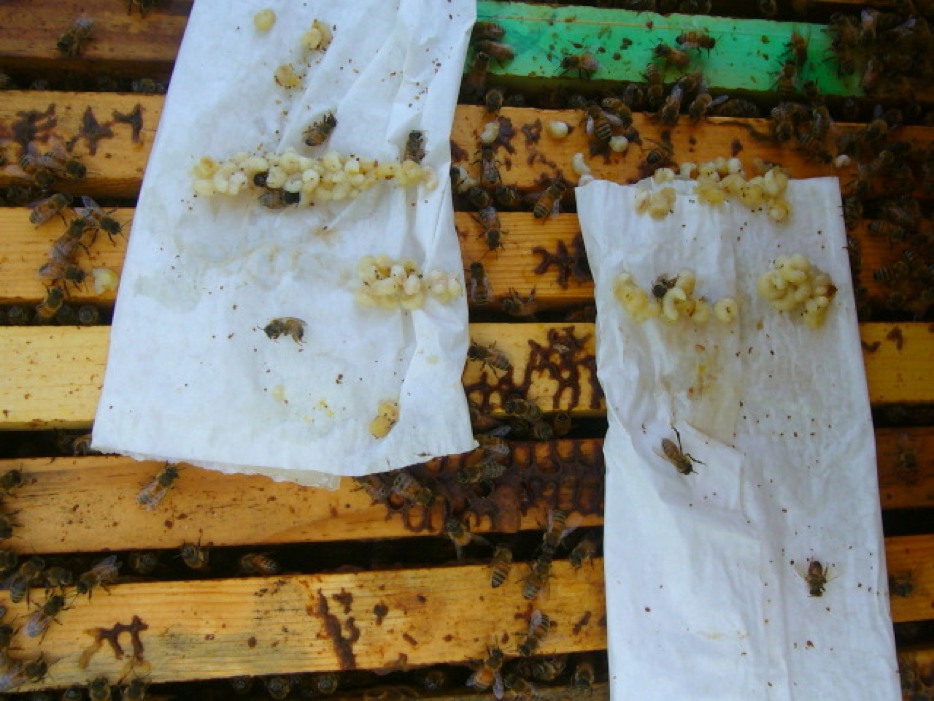
At 24 hours mail application, some colonies had expressionless older larvae piled on the strips and bottom boards. This brood impale was non credible in all hives, and was very short term. Note the numerous killed mites that take likewise fallen.
six/12–Day 4 (72 hrs post treatment)
Grass browning in front of hives. Bees interim commonly in treated hives–starting to chew out MAQS'south. Strips withal olfactory property of formic, simply not as strong.
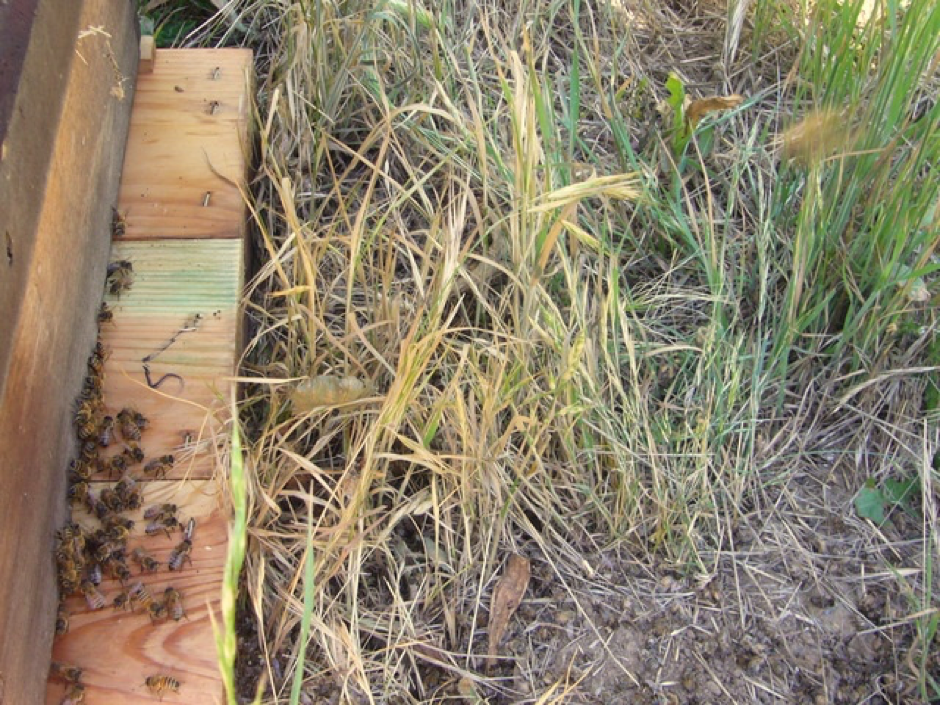
The acrid aroma of formic acid is noticeable in the exhaust air coming from the entrance. The formic acid fumes killed the grass and weeds in front end of the hive.
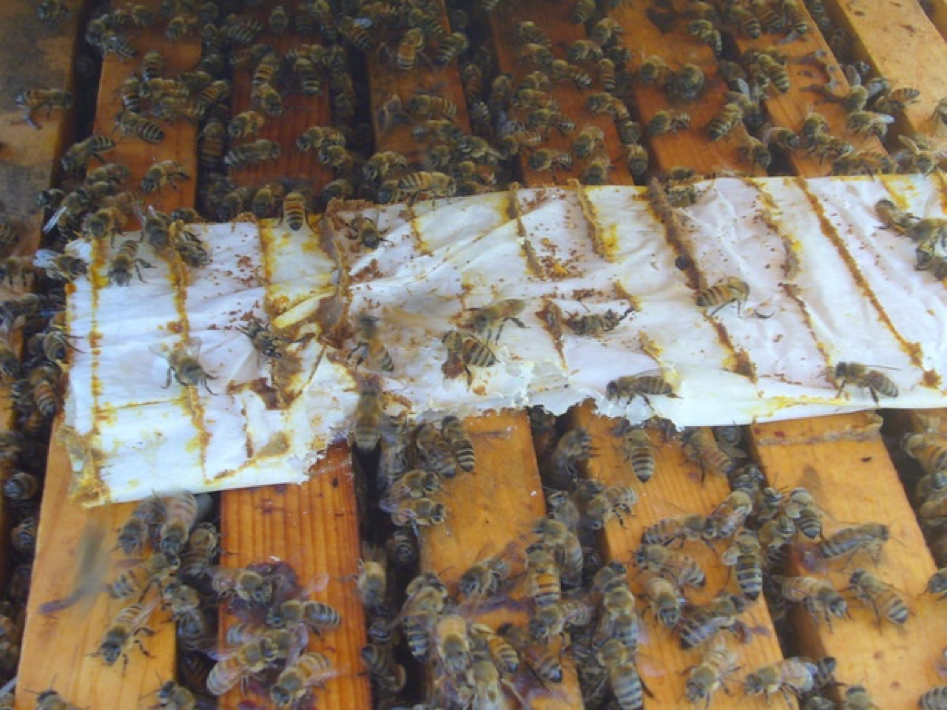
Past 3 days after application, the strips had lost much of their aroma, and the bees were either ignoring them or chewing them away.
half-dozen/15/11—Solar day vi post treatment
All colonies acting normal. Strips take piddling smell. Bees appear to be ignoring strips.
half dozen/18/11—Day nine postal service treatment
Inspected frames. Substantial breed loss in all treated, but less in ready backs and single strips. Those by and large still had some brood of all ages, and more sealed brood. Little sealed brood left in normal treatment.
By brood evolution math, queens shut down laying for iv-five days, and then resumed, often in outer frames or in top box.
Treated hives appear to have somewhat less adult bee strength compared to controls.
Only one lost queen (2-strip treatment). Notwithstanding, in that location had been queen loss in 2 of the grouping just prior to treatment, so non certain if from handling.
All other queens looking fat and fit, and laying like mad. Lots of eggs and one-two mean solar day larvae, some in upper boxes, some in lower, large hive-to-hive variation.
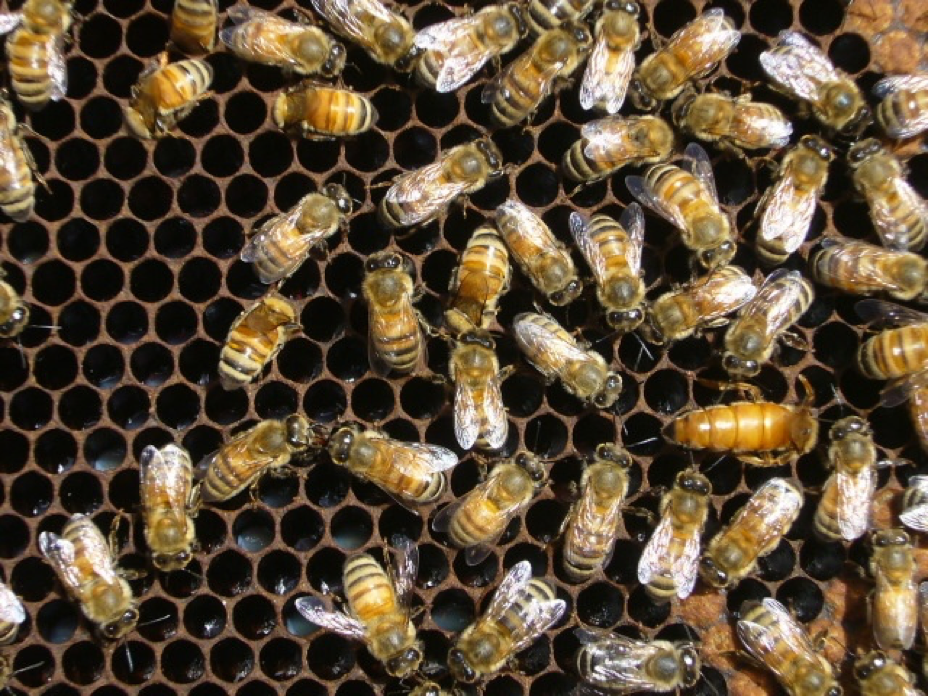
A queen laying like mad. The young brood was swimmin' in jelly. Other beekeepers have also commented that after the curt suspension in egglaying, the queen and nurse bees get back to broodrearing with a vengeance.
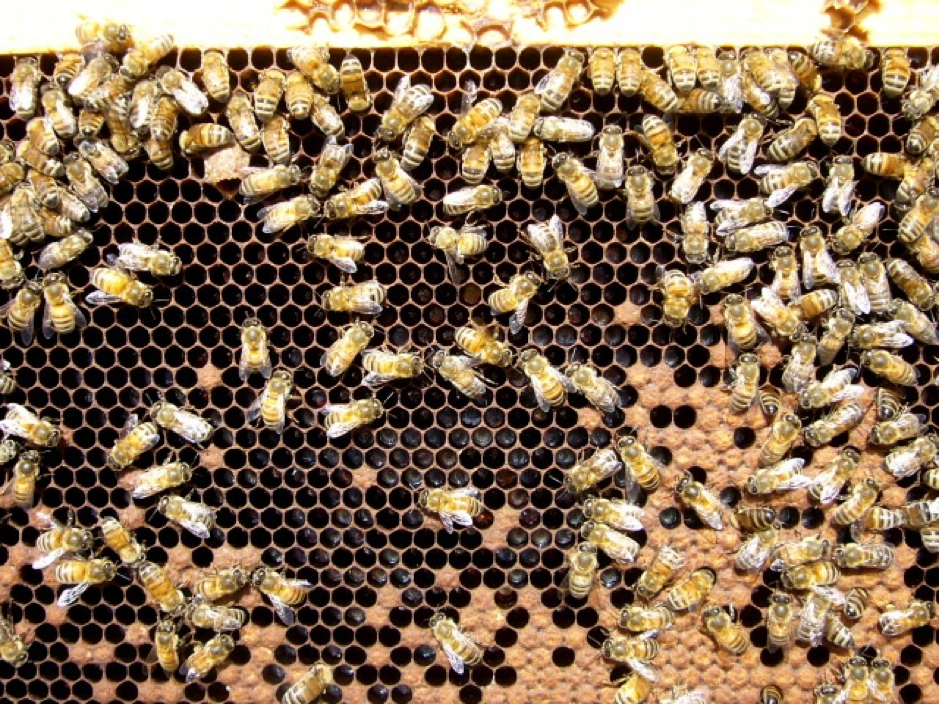
There was piffling sealed brood remaining in the two-strip unventilated hives, indicating that the open breed had been killed during treatment. However, not all colonies exhibited such loss. This photo is from a single-strip hive, in which the brood of all ages survived.

One colony suffered queen loss, although I take no idea whether it was from my mishandling, normal failure (others in the group had failed in the previous weeks), or from the strips. However, supersedure progressed usually, and the new queen was laying her middle out by the end of the trial.
7/vii–24-hour interval 28 mail handling

The daily high temperatures for the get-go few days of heavy outgassing from the strips were in the mid to high 70's. The hives were dark colored and in full sun.
Heavy nectar shake. Some hives starting to plug, so ended trial. Atmospheric condition hot—about 90F.
Sealed brood looked very expert in MAQS-treated hives, but likewise looked nifty in the controls!
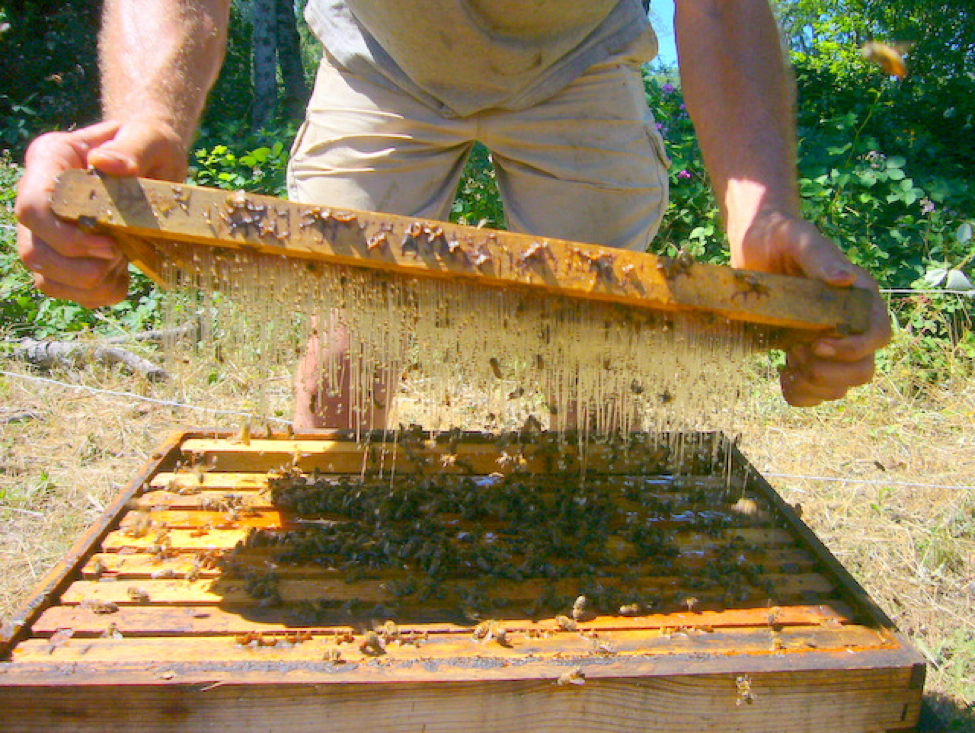
There was a heavy nectar milkshake past the end of the trial, so information technology was a good test of any handling effect upon nectar gathering. Thanks to helper Jed Nelson and his quick trigger finger for this shot!

All colonies, treated and control, looked slap-up with nice brood patterns.

The bees do a poor task of removing the spent strips, and tend to propolize them in place. However, they tin be easily scraped off with a hive tool.
Results

Since this was such a modest data set, I'm non running any statistics, except for the medians (which, as opposed to ways, ignore outlier values). By this date, a full brood cycle had been completed since the queens restarted at laying, and so mite washes probable reflected the actual mite levels in the hives. The mite counts in the controls roughly doubled, as would be expected. Mite levels were reduced past about 90% in the unventilated treatments, and past about 77% in the ventilated hives.
Note: hive #6, which superseded, had no sealed brood, which means that its last mite count would be skewed college. However, since I used medians to compare, it didn't affect the grouping mite reduction percent to any dandy caste.
Treatment with MAQS at the beginning of the flow did not appear to bear on beloved yields, equally the 2-strip unventilated hives had the same weight gain as the control grouping. Oddly, the setback and i-strip hives exhibited greater weight gain, merely I take no thought whether that was a fluke, or whether a moderate amount of formic acid exposure stimulates foraging.
An Boosted Trial
The manufacturer needed triplicate replication of "tolerance" trials of MAQS for European registration (trials to decide the rubber of the product to bee colonies). Since there was an unusual heat wave in Ontario this June; David took advantage of it, and applied MAQS at or above the maximum temperature recommended past the label (92°F, 33°C). He has given me permission to share the details.
- 23 colonies in Langstroth manner hives of various configurations, ranging from single breed chambers, no supers, up to two brood chambers and multiple supers.
- The 3 sites in the trial represented various typical bee yard locations: fully open to the dominicus and wind; partially shaded on a hillcrest, good air movement; full sun exposure most of the mean solar day, shaded late afternoon, well protected by dense tree environs.
- Colonies varied in strength from below the recommended 6-frame minimum (4 frame was the smallest at time of awarding, it expanded to 5 frames by the time of the post application examination) to greater than 20 frames.
- Queens were from 2009 or, if they had been superseded, 2010.
The colonies were evaluated on either Day 2 or eight mail treatment. Results: ane queen loss; breed pause in all other colonies varied from 0 – 4 days, with less of a break in larger colonies.
Give-and-take
Formic acid is an effective and well-proven miticide, merely with devilish problems in treatment prophylactic and in controlling the vaporization rate such that it will efficiently impale the mites without excessively harming the bees (which tolerate the fumes surprisingly well). MAQS is the about user-friendly formic awarding method that I accept seen to appointment.
Affects Upon Colony Behavior and Breed
Although the initial colony response (bearding, brood impale, and a break in egglaying) may exist shocking when you offset see information technology, the bees go over information technology in a few days and move on with their business organization. There is a surprisingly large colony-to-colony variation in response to formic fumes—bees in some hives largely ignore it, and there is no brood impale or egglaying break; in others you lose a week'south worth of brood. Larger colonies and those in better ventilated hives tend to suffer less from the fumes, only there are surprises—hither'south a notation that I received from one apiculturist:
"Yesterday I looked at thirty or so singles that got ii strips nether the hat, no supers–no apparent harm. 1 even nevertheless had an archway reducer on. Go figger!"
Effect Upon Queens
Reports of excessive queen loss due to handling appear to exist largely unfounded, provided that the product is applied properly. Further communication with the afflicted beekeepers revealed that the natural queen loss rate of surrounding beekeepers during the same time period (merely who hadn't treated) was as well unusually high. Here'southward a follow-up e-mail from a beekeeper who had earlier suspected major queen loss:
" I have now gone through all my treated colonies, and they are bouncing back pretty well, as forecast. The nurses plainly went some time without larva to feed as there is now a superabundance of pap in the cells, only like when jail cell starters go for days waiting for larvae to feed. Lost some queens, just not as bad as it looked previously. They are accepting the replacement queens well. If information technology cleans the mites as well as claimed, it is well worth it. I call back that I may take overreacted somewhat."
The results of this trial, and of others that I've seen the data from, do not point that MAQS handling causes excessive queen losses.
One surprising anecdotal observation by others is that colonies bargain with formic treatment ameliorate during subsequent applications—even if months later! Since few worker bees alive that long, this observation suggests that it may be an outcome of the queen response.
Efficacy of Mite Impale
The mite kill was pretty impressive—about 90% reduction at 4 weeks, as compared to almost a 100% increment in the control hives! This very limited data prepare suggests that the impale charge per unit may have dropped when ventilation was increased by setting the upper boxes back.
On the other hand, I was surprised past the credible high efficacy of the single strips. Notwithstanding, when I rechecked again on Day 43 postal service handling, counts for the ii single-strip hives (8 and 5 mites) were college than those of the two 2-strip hives that I tested for comparison (3 and 0 mites). This is a very small data set, but appears to ostend the manufacturer's findings that two strips are necessary for all-time mite control.
I was hoping to get adequate mite control past the application of a single strip, similar to the way in which I utilize a half handling of Apiguard gel, since the unmarried strip application appeared to exist easier on the bees. Even so, a single-strip application may be enough for a relatively beneficial quick mite knockback (Disclaimer: I am not recommending any departure from the label directions!).
Speaking of the label, the EPA's requirement that applicators wear protective gear and respirators is zilch short of impaired! The product is extremely condom to use, and that restriction volition likely prevent many commercial operators from having employees utilise the strips. This is extremely unfortunate, as MAQS could be a beekeeper'due south salvation if mite counts become high while love supers are on.
Event Upon Honey Production
My business that colony disruption by the strips would negatively impact my honey crop also appears to be unfounded. In fact, a brood break just at the start of the flow may exist of benefit, every bit per the Killian method of comb dearest product.
At this point I've reviewed or collected a fair corporeality of data on the results of MAQS awarding—the manufacturer is very cooperative, and IMHO has tested it thoroughly. Nonetheless, MAQS is a new production, and equally such, I suggest that yous experiment with it on a portion of your hives beginning. I'm sure that with fourth dimension, beekeepers volition learn to tweak the timing and application for best results.
Disclaimer
I have no financial interest in MAQS. This study was funded by donations from Joe Traynor, the Virginia State Beekeepers Clan, and other donors listed at ScientificBeekeeping.com.
How To Use Mite Away Quick Strips,
Source: https://scientificbeekeeping.com/an-early-summer-test-of-mite-away-quick-strips/
Posted by: lovelandlosting.blogspot.com



0 Response to "How To Use Mite Away Quick Strips"
Post a Comment